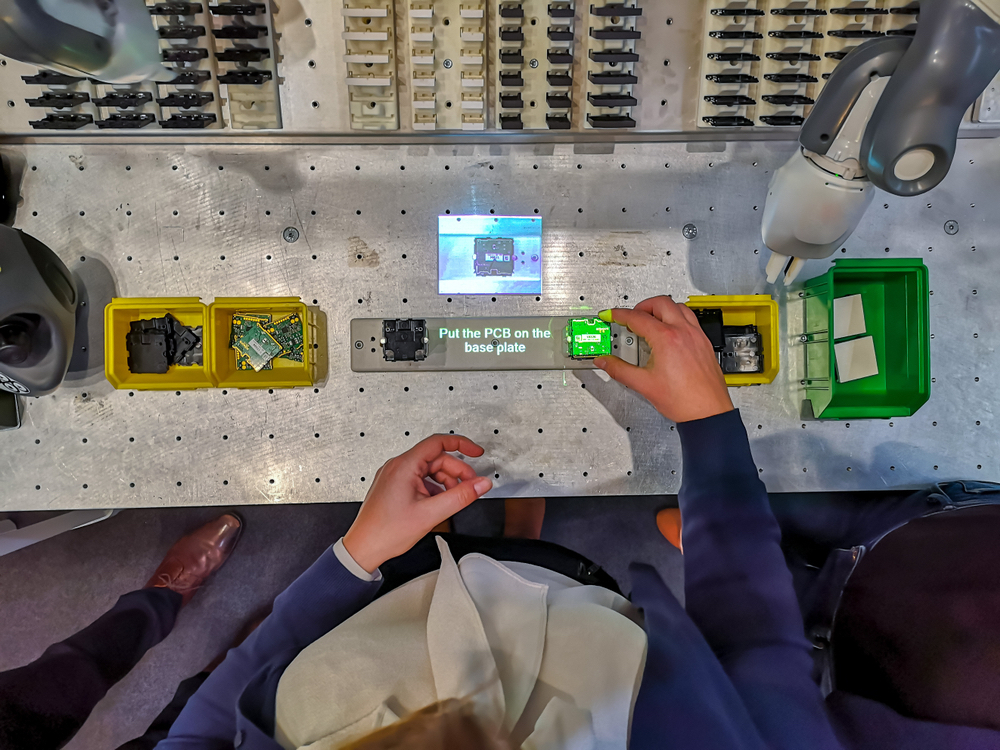Operator guidance system: a look into the future. With theater technology in a supporting role
A camera and a projection system for one fixed workstation. That’s what operator guidance looks like today. But what else is possible with this technology? The answer can be found in Kortrijk. Timen Floré, director of our site in Waregem, explains.
When you want to see the future of manufacturing, you have to pay a visit to Kortrijk. It’s the joint ambition of UGent and Flanders Make to make tomorrow’s production processes tangible. They do this by bringing various themes into practice at the Kortrijk site of Flanders Make. We engineered and built one of those themes: operator guidance. Or how technology can support operators in their job.
Operator guidance system: the practice today
Operator guidance is now usually done with a camera and/or projection system above the operator’s workstation. The camera records and monitors the actions, and the projection system makes clear what needs to be done. For example, the guidance system will first highlight a screw and then show where the operator should mount it.
The photo below shows a system that projects the instructions step by step onto the workstation. At the same time, a screen shows the expected outcome.
 An in the field example of operator guidance.
An in the field example of operator guidance. “We have already integrated operator guidance in several of our projects,” Timen says. “For example, to correctly supply certain parts to a machine. We set up a workstation with a screen that showed the operator which parts had to go where on the tray. A camera checked the actions and whether everything had been sorted out correctly.”
The future: a moving guide
That is an example from today’s practice. But what might such a guidance system look like in the future?
Much more dynamic, as it turns out.
Whereas we tend to think of one workstation and a fixed set-up, we now designed and built a system for UGent and Flanders Make that can cover a much larger floor area. A guide that moves with the operator and thus provides support during multiple tasks. “That means that the camera – or in this case two cameras, are not static. They are not fixed in one place, but they can maneuver.”
“To achieve this, we have assembled a framework of 4 by 12 meters that can hang from the ceiling. In the hall of Flanders Make the frame is secured at a height of ten metres, but we engineered and built the system in such a way that it can operate at any height.”
Below: a timelapse that shows the the framework being assembled.
A leading role for the theater
A big frame, anchored in the ceiling. With two cameras constantly moving above the operator’s head. How can one guarantee the safety of that operator? “This indeed poses risks. We started looking for the solution in theatrical techniques. Because this frame is actually a truss – one of the structures hanging above a stage that holds the spotlights.”
“On stage, the risks are very similar: a suspended load above people’s heads. In theatre, they work with an a technology developed specifically for the hoists holding the weight. So part of the possible future of our manufacturing industry comes from a world you wouldn’t expect.”
XY slides
“To make the cameras move, we worked with XY slides, to enable a linear movement. This allows both cameras to position themselves correctly relative to the operator along the X and Y directions.”
“That freedom of movement poses another challenge to the frame: potential deflections. If the cameras move, it must not affect the structure. First, to avoid the risk that the slides can no longer move smoothly. Second, because everything is about precision: the cameras must be able to follow everything the operator does very closely. The solution was to engineer and build a scissor structure that provides the necessary stability.”
“It was really a challenge to get everything right for this operator guidance system. To have those slides move along with an operator over such a distance. And to make that happen with extreme precision and with the right acceleration each and every time.”
Operator-independent
“This was a tremendously exciting project”, Timen reflects. “We gained experience and knowledge that we now can apply in our next projects.”
“I expect that operator guidance will increasingly become a part of the machines we as VINTIV build and retrofit. After all, it is ionpart of the solut to make your processes and products less operator-dependent. The right guidance technology makes it possible for younger or inexperienced colleagues to achieve the same quality as the more experiences operators within a company. It makes machines more accessible to a wider audience. Just as better visualization and remote support do.”